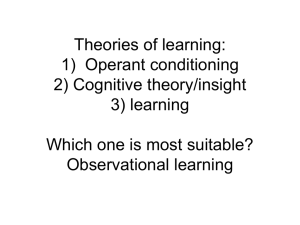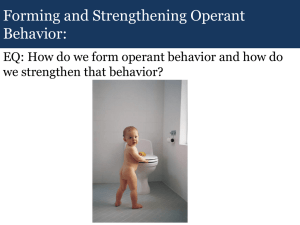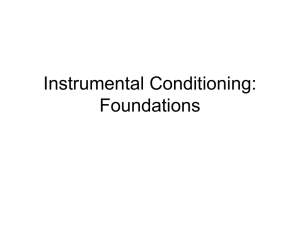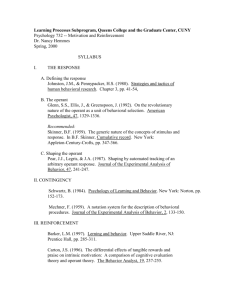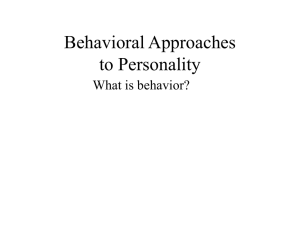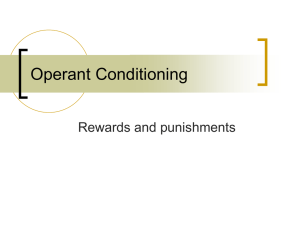Psy 360 Learning
advertisement
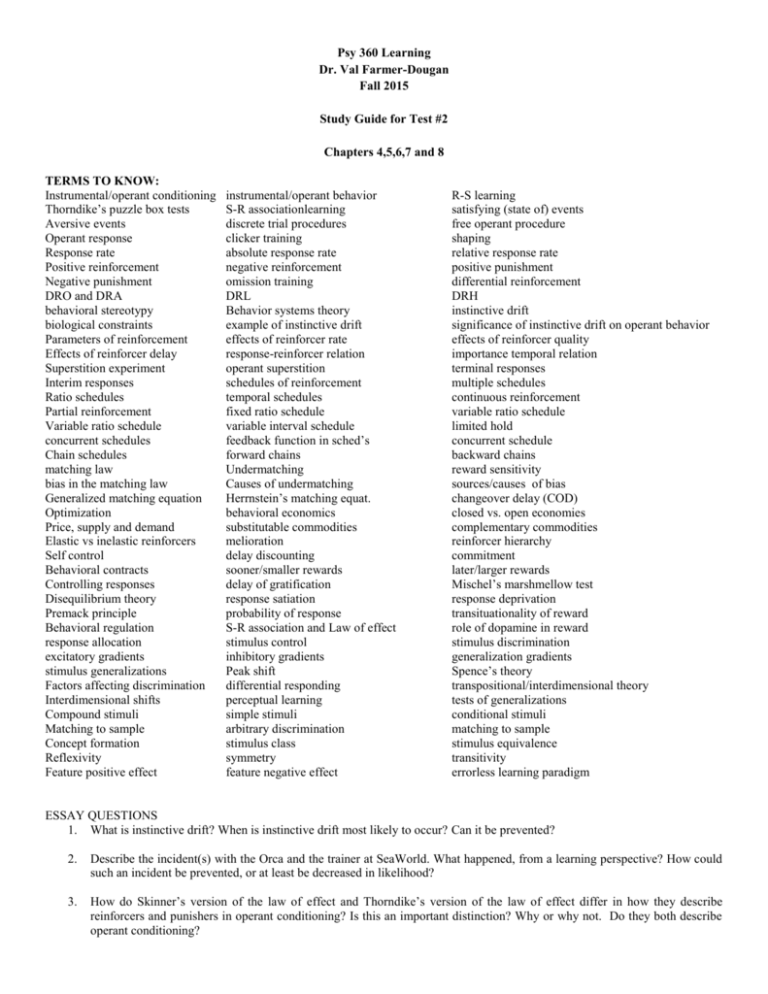
Psy 360 Learning Dr. Val Farmer-Dougan Fall 2015 Study Guide for Test #2 Chapters 4,5,6,7 and 8 TERMS TO KNOW: Instrumental/operant conditioning Thorndike’s puzzle box tests Aversive events Operant response Response rate Positive reinforcement Negative punishment DRO and DRA behavioral stereotypy biological constraints Parameters of reinforcement Effects of reinforcer delay Superstition experiment Interim responses Ratio schedules Partial reinforcement Variable ratio schedule concurrent schedules Chain schedules matching law bias in the matching law Generalized matching equation Optimization Price, supply and demand Elastic vs inelastic reinforcers Self control Behavioral contracts Controlling responses Disequilibrium theory Premack principle Behavioral regulation response allocation excitatory gradients stimulus generalizations Factors affecting discrimination Interdimensional shifts Compound stimuli Matching to sample Concept formation Reflexivity Feature positive effect instrumental/operant behavior S-R associationlearning discrete trial procedures clicker training absolute response rate negative reinforcement omission training DRL Behavior systems theory example of instinctive drift effects of reinforcer rate response-reinforcer relation operant superstition schedules of reinforcement temporal schedules fixed ratio schedule variable interval schedule feedback function in sched’s forward chains Undermatching Causes of undermatching Herrnstein’s matching equat. behavioral economics substitutable commodities melioration delay discounting sooner/smaller rewards delay of gratification response satiation probability of response S-R association and Law of effect stimulus control inhibitory gradients Peak shift differential responding perceptual learning simple stimuli arbitrary discrimination stimulus class symmetry feature negative effect R-S learning satisfying (state of) events free operant procedure shaping relative response rate positive punishment differential reinforcement DRH instinctive drift significance of instinctive drift on operant behavior effects of reinforcer quality importance temporal relation terminal responses multiple schedules continuous reinforcement variable ratio schedule limited hold concurrent schedule backward chains reward sensitivity sources/causes of bias changeover delay (COD) closed vs. open economies complementary commodities reinforcer hierarchy commitment later/larger rewards Mischel’s marshmellow test response deprivation transituationality of reward role of dopamine in reward stimulus discrimination generalization gradients Spence’s theory transpositional/interdimensional theory tests of generalizations conditional stimuli matching to sample stimulus equivalence transitivity errorless learning paradigm ESSAY QUESTIONS 1. What is instinctive drift? When is instinctive drift most likely to occur? Can it be prevented? 2. Describe the incident(s) with the Orca and the trainer at SeaWorld. What happened, from a learning perspective? How could such an incident be prevented, or at least be decreased in likelihood? 3. How do Skinner’s version of the law of effect and Thorndike’s version of the law of effect differ in how they describe reinforcers and punishers in operant conditioning? Is this an important distinction? Why or why not. Do they both describe operant conditioning? 4. Briefly describe the four basic reinforcement schedules (VI, VR, FI, FR) and how behavior patterns should be different between each of them. Be sure and give a real world example for each type of schedule. 5. Are reward and punishment simply opposites, or are they qualitatively different? That is, do the same parameters apply to both reinforcement and punishment, and can we quantify reward settings such that x number of reinforcers equals x number of punishers? Defend your answer! 6. How does extinction during operant conditioning differ from extinction during classical conditioning? Why is this important to know in clinical settings? 7. What does Herrnstein mean by "matching"? His 1970 equation was P = kR/R + Ro. Explain what P, k, R and Ro are, and how this equation can demonstrate that an animal “matches”. 8. Baum's (1974) generalized matching law is: B1/B2= k(R1/R2)a. What does B1, B2, k, R1, R2 and a stand for (hint, I use a b instead of k)? What does “matching” mean, according to this equation? 9. According to Baum’s matching law, what is undermatching? What might cause undermatching? What is bias? What might cause bias? 10. What is behavioral contrast (briefly describe the phenomenon). Show how Baum’s Generalized Matching Law predicts this. Give a real world example of how understanding the Generalized Matching Law might help you better utilize a reinforcement program. 11. What is meant by disequilibrium, according to disequilibrium theory? What is response deprivation and response satiation? Finally, how is the disequilibrium model an improvement over Premack’s model? 12. Describe stimulus control and explain why this is such an important concept for operant conditioning. Give at least three examples of the importance of stimulus control in applied settings. 13. What is errorless learning? Why does errorless learning offer an improvement in teaching stimulus control? Give three examples of how errorless learning could be used for teaching psychology. 14. What are the feature positive and feature negative effects? How are these effects demonstrations of a biological boundary on learning? 15. Using what you know about Feature positive and Feature Negative effects, why is a multiple choice question which asks “which of the following is NOT one of the ……” more difficult than “which of the following is an example of….” Test will consist of: 6 3 2 5 point definitions 10 point compare and contrasts 20 point Essay questions (given 3, write on 2) 30 points 30 points 40 points The terms for the definitions and compare/contrast will come only from this study guide. The two essay questions given on the test will be copied VERBATIM from this study guide. You choose which one of the two to answer.
